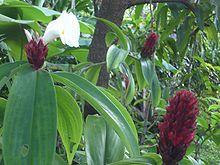- Costus speciosus
-
Crape Ginger 
Scientific classification Kingdom: Plantae (unranked): Angiosperms (unranked): Monocots (unranked): Commelinids Order: Zingiberales Family: Costaceae Genus: Costus Species: C. speciosus Binomial name Costus speciosus
(J.Konig) Sm.Costus speciosus or Cheilocostus speciosus or crape ginger is possibly the best known cultivated species of the genus Costus. This plant is native to southeast Asia, especially on the Greater Sunda Islands in Indonesia. Costus differs from the common ginger by having only one row of spirally arranged leaves.
The species reproduces vegetatively by rhizome and birds disperse seeds when they feed on the fruits.
While it is native to many Pacific Islands, it is an introduced invasive species on others, including the Cook Islands, Fiji, and Hawaii. It is cultivated in India for its medicinal uses and elsewhere as an ornamental.
Habitat: Roadside ditch, low lying areas in the forest. Flowering season starts after rainy season, October to December.
The plant has many historical uses in Ayurveda, where the rhizome has been used to treat fever, rash, asthma, bronchitis, and intestinal worms. It is mentioned in the Kama Sutra as an ingredient in a cosmetic to be used on the eyelashes to increase sexual attractiveness.C. speciosus has a large number of common names in many languages, including isebsab (Palauan), keu or kemuk or keumul (Bengali), keukand (Hindi), Thebu (Sinhala), pakarmula (Gujarati), pushkarmula (Marathi and Sanskrit),Jom Lakhuti (Assamese) and kostam (Tamil).
Gallery
-
Costus speciosus in Basse Terre, Guadeloupe.
-
Costus speciosus in Hawaii.
External links

This Zingiberales-related article is a stub. You can help Wikipedia by expanding it.




